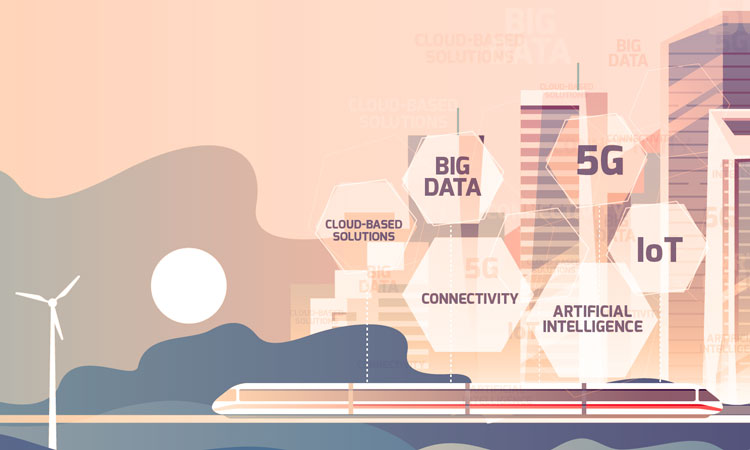Performance on point: The role of collaboration and data in shaping rail’s future
Posted: 8 July 2021 | David Clarke | No comments yet
For Global Railway Review, David Clarke, Technical Director at the Railway Industry Association (RIA), explores the importance of collaboration and how it will be a driving force in the industry’s COVID-19 recovery.


Though passenger numbers fell dramatically when the pandemic hit, the UK rail industry rose to the challenge of keeping the network running for essential workers and freight transportation, while ensuring the safety of both travellers and staff.
Key to the almost overnight shift in operations was enhanced collaboration across the industry to roll out innovations in rapid time. Take, to name just one example, Thales’ work with Network Rail’s R&D Accelerated Innovation programme to install thermal cameras across 100 essential sites in a matter of weeks to monitor body temperatures and identify COVID-19 fever symptoms.
Now, as we get moving again and numbers on trains increase, we must continue to foster such an innovation-friendly environment, to create long-term solutions to perennial challenges that have hampered the industry’s reputation.
But how? In this article, I’ll review some of the pioneering innovations developed in response to issues such as weather, rail maintenance and repair and disruption to customer journeys. We’ll consider the vital role that the sophisticated tracking, monitoring and analysis of data has to play, and the role of collaboration in pushing forward solutions that can meet evolving staff and passenger expectations.
Harnessing technology to prepare and prevent
With, typically, 24,000 trains operating per weekday on UK tracks, management and maintenance is a never-ending cycle to ensure that all infrastructure is fit for use. It’s an essential task; yet, it is one that has, historically, resulted in delays, diversions and cancellations to passenger and freight journeys.
With, typically, 24,000 trains operating per weekday on UK tracks, management and maintenance is a never-ending cycle to ensure that all infrastructure is fit for use.
Take the cyclical issue of leaves on the line. You’ll likely be aware that, when heavy wind and rain cause large amounts of leaves to fall and stick to track rails, it can present serious safety concerns – as the heat and weight of trains passing over them bakes a thin, slippery layer onto the rail. What you might not appreciate is that the time taken to remove them, as well as address the other issues caused by adverse weather conditions, can cost £50 to £100 million per year due to delays and cancellations, rising to £200 to £300 million when factoring the wider associated costs to the railway and economy.
We have recently seen collaboration in the market to address this. For example, PlasmaTrack completed its R&D phase early in 2020 which, sponsored by the Rail Safety and Standards Board (RSSB), took its efficient and scalable technology through three phases of development – from a lab-based concept into a railway-ready prototype tested with Network Rail. Safely and securely mounted to each train ahead of the wheel rail interface, this plasma technology clears the residue on tracks, returning the surface to a dry, clean and uncontaminated state – enabling trains to run on near-perfect conditions and helping to ensure controlled braking in all environmental conditions. Once fully implemented, this innovation brings the potential to avoid unnecessary damage to tracks and delays to scheduled timetables, increasing capacity on the network at the same time.
We’re also seeing new solutions to help to address issues before they even have a chance to impact operations. For example, One Big Circle developed the phone-sized AIVR (Automated Intelligent Video Review) that sits inside the windscreen, or in the Tail Lamp bracket housing, of any operational vehicle and automatically captures video data and telemetry whilst on the move. Engineers can now view ‘what the train sees’ – critical lineside video data with location, measurement, mark-up and sharing tools. Powered with this knowledge, they can then monitor, assess and act on any issues to the railway environment, such as vegetation growth as a direct result of rail use. Recognising the huge value that this solution delivers, it is now being deployed across Network Rail and Transport for Wales’s (TfW) infrastructure.
Dialling down disruption through data
…we are seeing more data-enabled technology used by the industry to monitor the health of rail infrastructure in order to mitigate delays and disruption.
Building on the above, Atkins collaborated with Network Rail’s R&D Portfolio and Train Rail Infrastructure Solutions to develop OLE-StAT, which builds on Network Rail’s existing Measurement Train (NMT) infrastructure, using data to further analyse and predict potential issues before they’ve occurred. The NMT uses lasers to survey overhead line equipment remotely, and the OLE-StAT enhances this system by collecting, interpreting and analysing data on the health of infrastructure. A visual dashboard is created, highlighting and categorising any areas of concern. In tandem to predicting potential issues, this has significant workforce safety benefits – helping to remove the need for staff to be physically present on the side of tracks. Ultimately, it shows what Network Rail’s Accelerated Innovation programme is all about: driving innovation through collaboration across the industry.
Indeed, we are seeing more data-enabled technology used by the industry to monitor the health of rail infrastructure in order to mitigate delays and disruption. D/Gauge’s recently enhanced suite of ‘self-service’ gauging software offers real-time access to assessment datasets that measure the clearance around a moving train – thus ensuring its safe operation, while capturing and recording data to ensure that engineers avoid risky assessments. SWIX SCT, meanwhile, harnesses real-time data to remotely monitor track substructure and critical switch components to extend asset life, eliminate failures, reduce downtime and improve maintenance. It uses sensors to identify, capture and store data on the switch components and substructure wellbeing each time rolling stock passes the site.
A bright future ahead
What does this all point to? We should be positive about the prospects for rail in the future, as passenger numbers bounce back post-coronavirus.
Long-lasting change will require clarity and support from the government and buy-in across the supply chain to position the industry for the future.
Despite the unprecedented challenges that it has faced, the industry has proven how fruitful collaboration can be for dealing with pressing issues. We’ve seen cost and time-effective solutions to age-old problems – from mitigating risks to health and safety and predicting potential disruption to services – to help realise smoother operations and boost customer experience.
We can build on these learnings and ensure that rail is a preferred means of transport – easy to use for all passengers, packed with personalised services, guaranteed reliability of experience, a pioneering means of sustainable travel – with the effective use of data underpinning innovation and operations. Delivering this across the entire network is key; solutions cannot sit in silos. Long-lasting change will require clarity and support from the government and buy-in across the supply chain to position the industry for the future.


Related topics
Big Data, Coronavirus/COVID-19, Technology & Software, Track/Infrastructure Maintenance & Engineering
Related organisations
Network Rail, Rail Safety and Standards Board (RSSB), Railway Industry Association (RIA), Transport for Wales (TfW)








